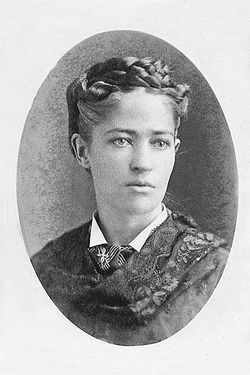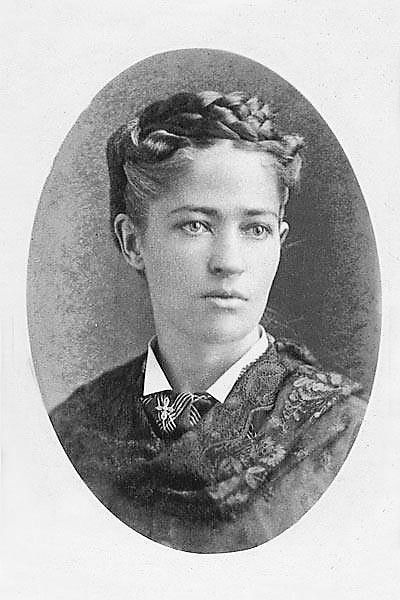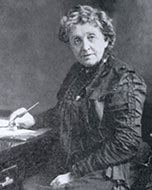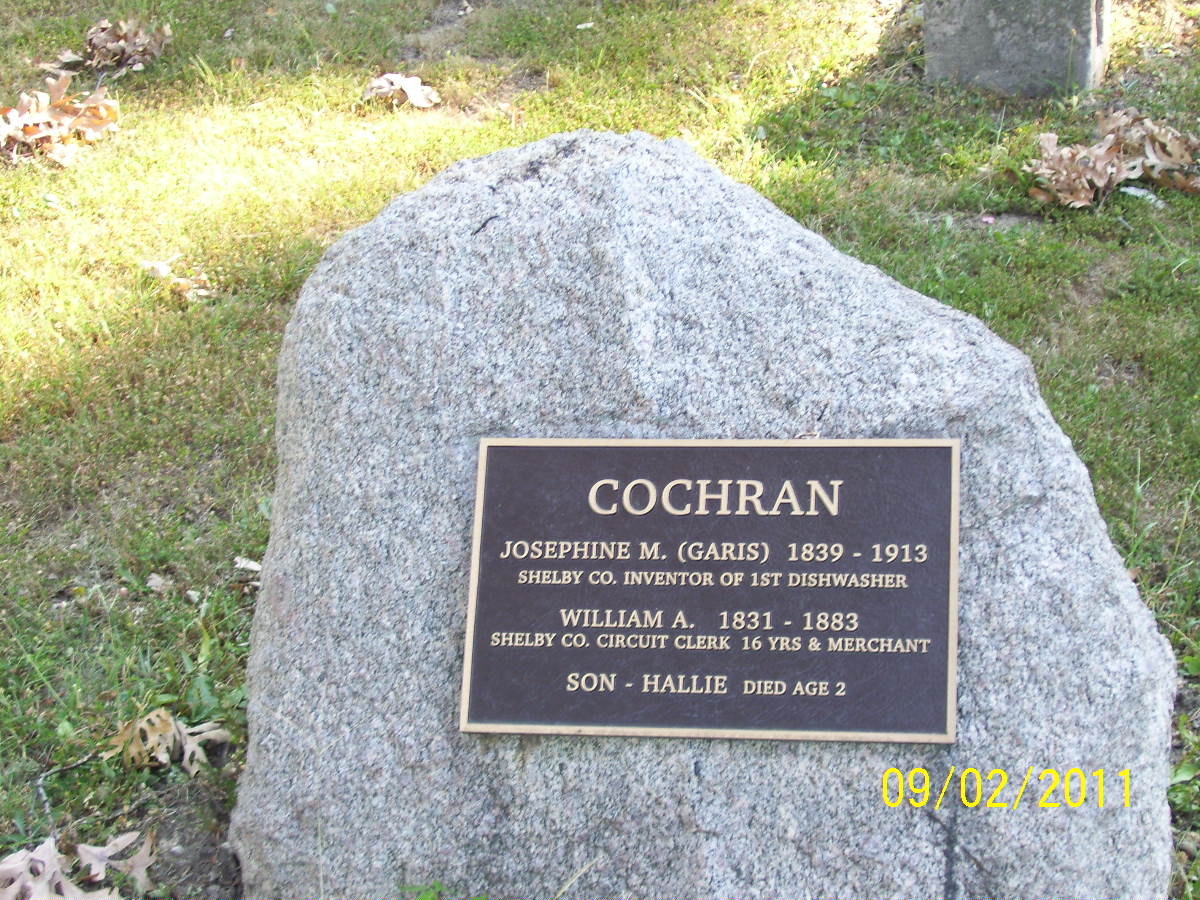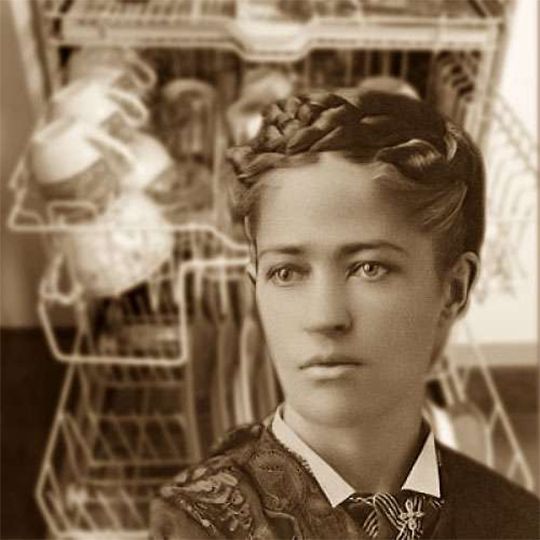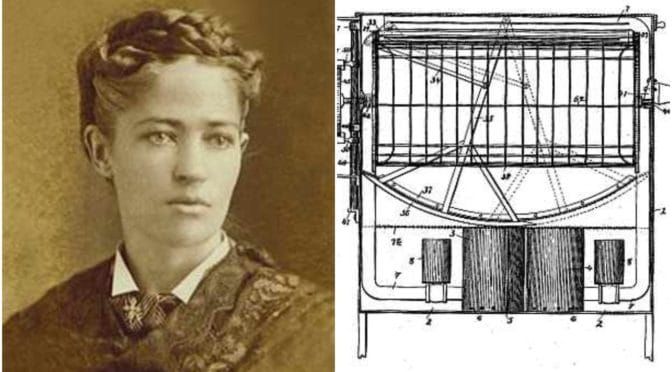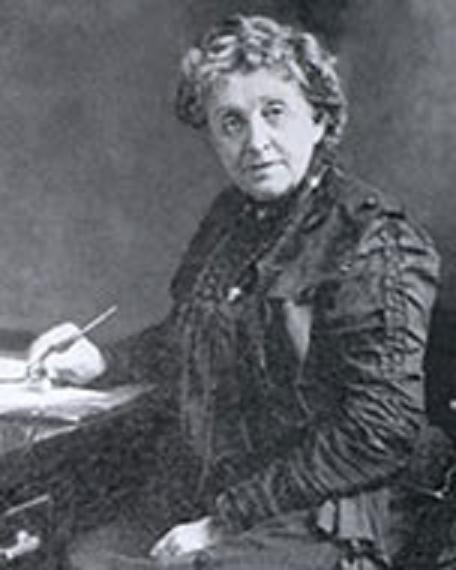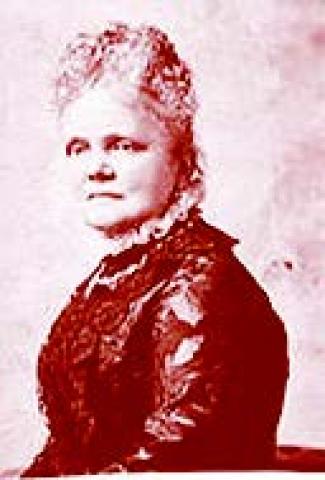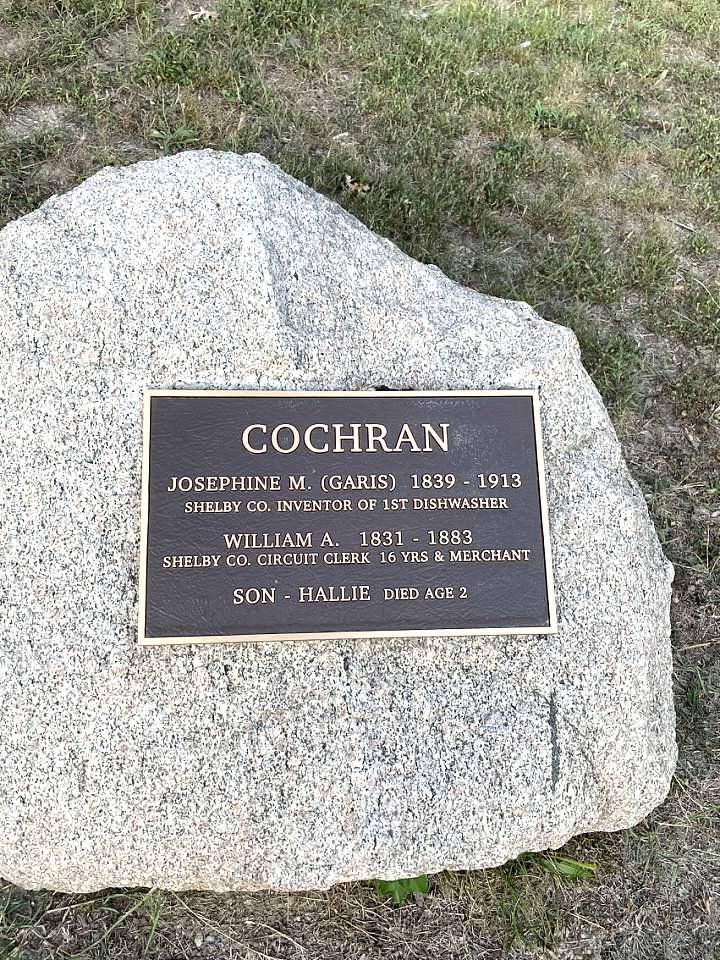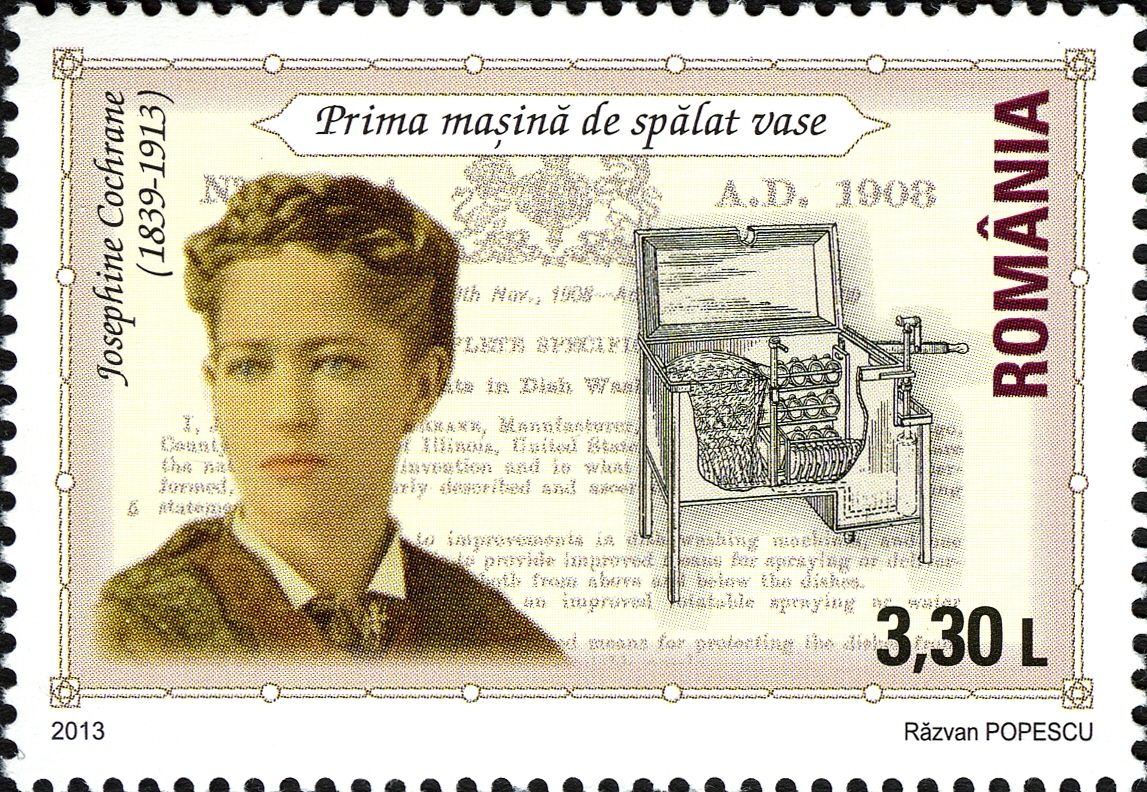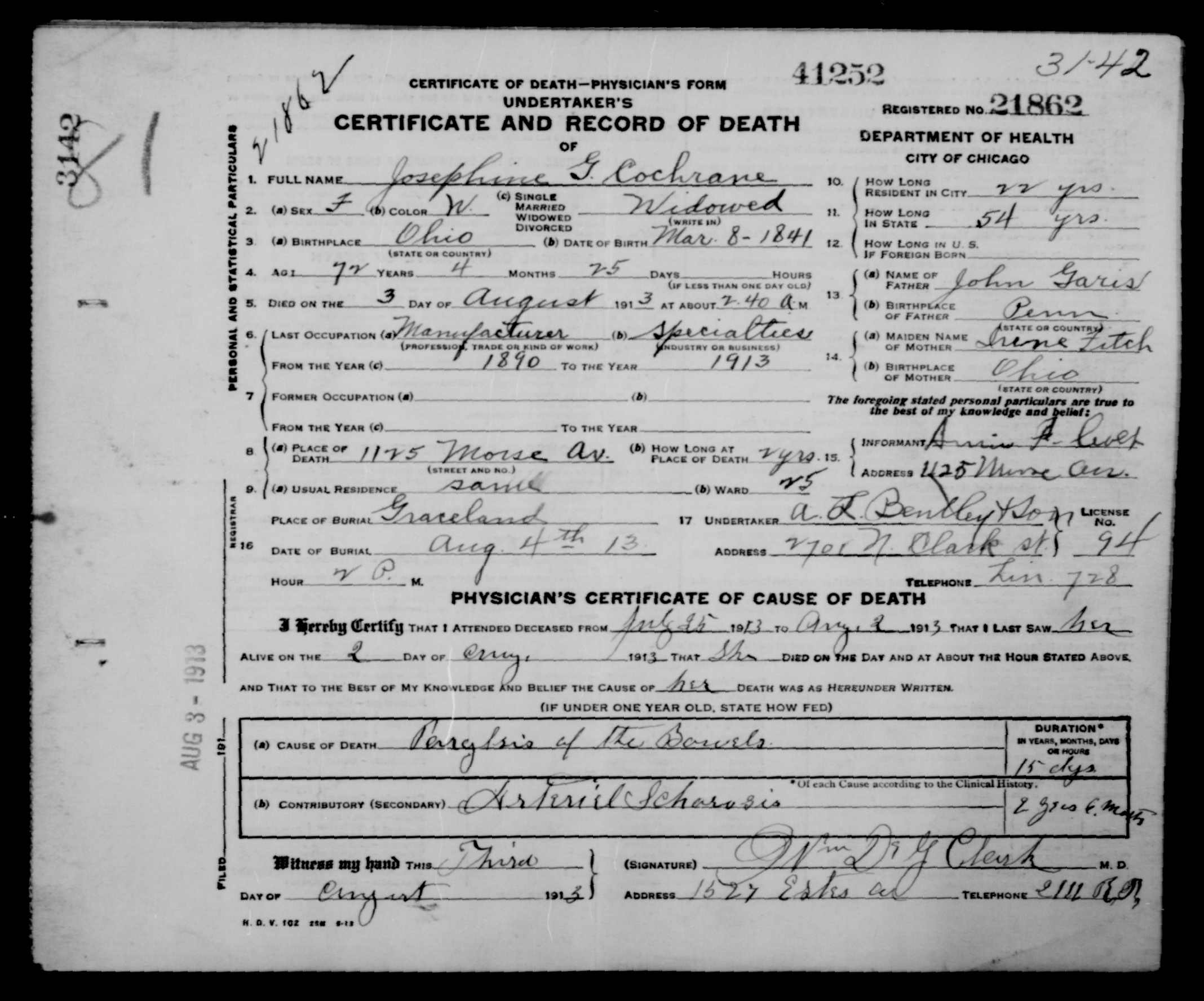Our Best Words, Chautauqua Number, August 20-31, 1913, p 3 c 1, Vol. XXXIII No. 8 (This newspaper was published by Josephine's pastor [Jasper Douthit] in Shelbyville)
In Memory of Mrs. Josephine Garis Cochran
Inventor of the Dishwasher
The ashes of all that was earthly of Mrs. Josephine Garis Cochran were deposited beside the grave of her husband and their little child, a son named, “Hallie,” in Glenwood cemetery, Shelbyville, Ill. Tuesday, Aug. 5, 1913. she left the earthly body at her home in Chicago, Sunday, Aug. 3, 1913, age 74. There was a simple, brief service at the grave conducted by Jasper L. Douthit, who served at the funeral of her husband, Wm. A. Cochran, who died Oct. 20, 1883, age 52. These Twain were married Oct. 13, 1858. They were both prominent persons in this community till death separated them. Mr. Cochran was one of the most widely known and popular public officials for years in the county. He and his wife were the first to unite with the Unitarian church, Shelbyville, in 1875 and were active, persistent and most generous members.
The following obituary was furnished by Janet Donner:
Shelbyville, Aug 5--Mrs. Josephine Garis Cochran, widow of the late William A. Cochran, who for many years was circuit clerk of Shelby county died at her home in Chicago Sunday morning after a years illness from heart trouble. While she had been sick for many months she did not become critically ill until two weeks ago, when she suffered a stroke of paralysis. Mrs. Cochran was seventy four years old and for almost a quarter of a century she had made her home in Chicago where she supervised the manufacture and sale of a dish washing machine of which she was the inventor and patented.
Mrs. Cochran was a daughter of the late John Garis widely known throughout Illinois as a surveyor, bridge builder and swamp land engineer before the great Chicago fire. Her mother was a Fitch direct descendant of John Fitch inventor of the steamboat.
The husband of Mrs. Cochran, William A. Cochran was circuit clerk of Shelby county from 18?1 to 1880. He was born at Cochrans Grove, near Windsor in 1831. He spent his entire life in this vicinity and was widely know as a school teacher in his early manhood and later as politician and public official.
Mrs. Cochran leaves an adopted daughter, two sisters and one brother. The funeral was held at the home in Chicago Monday afternoon. In accordance with the wishes of Mrs. Cochran, the body was cremated and the ashes will be brought to Shelbyville for burial beside the remains of her husband, arriving some time Tuesday. There will be no service at the cemetery.
∼Josephine Cochrane (March 8, 1841, Ashtabula County, Ohio - August 3, 1913)made the first practical mechanical dishwasher in 1886, in Shelbyville, Illinois., although a washing machine device was patented in 1850 by Joel Houghton (see Dishwasher, History). Mrs. Cochrane was a rich woman who held many fancy dinner parties. She did not do any of the dishes herself because she had servants to do that for her, but she wanted a machine that could do the job faster without chipping any dishes. No one had invented such a machine so she built one herself. She has always dreamed of being famous. She is said to have exclaimed, "If nobody else is going to invent a dishwashing machine, I'll do it myself!"[4] First she measured the dishes. Then she built wire compartments, each specially designed to fit either plates, cups, or saucers. The compartments were placed inside a wheel that lay flat inside a copper boiler. A motor turned the wheel while hot soapy water squirted up from the bottom of the boiler and rained down on the dishes.[5] Her friends were very impressed and had her make dishwashing machines for them, calling them the "Cochrane Dishwasher". Her friends talked a lot about their new machines and soon, Mrs. Cochrane was getting orders for her dishwashing machine from restaurants and hotels in Illinois. She patented her design and went into production. She showed her invention at the 1893 World's Columbian Exposition in Chicago and won the highest prize for "best mechanical construction, durability and adaptation to its line of work". She started the Garis-Cochran Manufacturing Company, which became part of KitchenAid, which became part of Whirlpool. She died in Chicago in 1917.∼daughter of John Garis, a civil engineer, and Irene Fitch Garis, as well as the granddaughter of an innovator.
American inventor Josephine Cochrane (1839 - 1913) came up with the idea of a mechanical dishwasher, one that would hold dishes securely in a rack while the pressure of a water sprayer cleaned them after servants chipped heirloom dishes. But when her husband William died in 1883, leaving her with substantial debt, making the dishwasher work and become profitable became a necessity.
She received the patent in 1886 and began marketing her dishwasher to hotels. "You cannot imagine what it was like in those days... for a woman to cross a hotel lobby alone," she told one reporter. "I had never been anywhere without my husband or father, the lobby seemed a mile wide. I thought I should faint at every step, but I didn't, and I got an $800 order as my reward."
In 1893 her dishwasher was exhibited at the World's Columbian Exposition in Chicago, making it into a household word. Cochrane continued selling her dishwasher until shortly before her death, and her legacy lives on. Her company was bought by KitchenAid in 1916, and Cochrane is still listed as one of its founders.∼American inventor who was the inventor of the first successful hand-powered dishwasher, which she designed, and then constructed with the assistance of mechanic George Butters, who became one of her first employees.
Once her patent issued on 28 December 1886, she founded Garis-Cochrane Manufacturing Company to manufacture her machines. Cochrane showed her new machine at the World's Columbian Exposition in Chicago in 1893 where nine Garis-Cochran washers were installed in the restaurants and pavilions of the fair and was met with interest from restaurants and hotels, where hot water access was not an issue. She won the prize for "best mechanical construction, durability and adaptation to its line of work" at the Fair. Garis-Cochran Manufacturing Company, which built dishwashers, grew through a focus on hotels and other commercial customers and was renamed as Cochran's Crescent Washing Machine Company in 1897.
Cochran's Crescent Washing Machine Company became part of KitchenAid through acquisition by Hobart Manufacturing Company after Cochran's death in 1913, who first grew the commercial business. Cochran was posthumously inducted into the National Inventors Hall of Fame in 2006 for patent 355,139 issued on December 28, 1886, for her invention of the dishwasher.
Cochrane was born Josephine Garis in Ashtabula County, Ohio, on March 8, 1839, and raised in Valparaiso, Indiana. She was the daughter of John Garis, a civil engineer, and Irene Fitch Garis, as well as the granddaughter of an innovator.
After moving to her sister's home in Shelbyville, Illinois, she married William Cochrane on October 13, 1858. William had returned the year before from a disappointing try at the California Gold Rush, but had gone on to become a prosperous dry goods merchant and Democratic Party politician. Josephine and William had 2 children: Hallie and Katharine.
In 1870 the family moved into a mansion and she joined Chicago society. After one dinner party, some of the heirloom dishes got chipped while washing up, prompting her to search for a better alternative to handwashing the china. She also wanted to relieve tired housewives from the duty of washing dishes after a meal.
Other attempts had been made to produce a commercially viable dishwasher. In 1850 Joel Houghton designed a hand-cranked dish soaker. In the 1860s, L. A. Alexander improved on the device with a geared mechanism that allowed the user to spin racked dishes through a tub of water. Neither of these devices was particularly effective.
Josephine Cochrane's invention of the dishwashing machine eventually became a success. However, this not only took a great deal of time and effort, but she also faced numerous obstacles in her journey to becoming a successful female innovator. Following the death of her husband in 1883, Cochrane was left with only $1,535.59 and a significant amount of debt which she had to pay off. This not only put her in a position of distress and mourning but also motivated her to create this innovation that she was passionate about and urgently needed to sustain herself financially. The death of her husband also put Cochrane in a trying position as a woman. She had to bring her invention to life, get a patent on it, find customers and sell her product to them all alone, with little to no representation and help of the male figures in her life. At the time, this would be difficult for any woman, no matter what their background or position was. In the following years, she worked hard on bringing her innovation to market, with little money, technical knowledge, and help to develop the mechanics of her pressurized dishwashing machine.
After filing her first patent application on December, 31st, 1885, she began developing a prototype of her product, bringing her vision to light. Cochrane designed the first model of her dishwasher in the shed behind her house in Shelbyville, Illinois. George Butters was a mechanic who assisted her in the construction of the dishwasher. He was also an employee at the first dishwasher factory. To build the machine, she first measured the dishes and built wire compartments, each specially designed to fit either plates, cups, or saucers. The compartments were placed inside a wheel that lay flat inside a copper boiler. A motor turned the wheel while hot soapy water squirted up from the bottom of the boiler and rained down on the dishes. Their dishwasher was the first to use water pressure instead of scrubbers to clean the dishes inside the machine. She received a patent on December 28, 1886.
Another challenge she faced was selling her product to individual households, specifically housewives. The first dishwashers were too expensive for an average household, costing between $75 and $100, which most women would not spend on an item for their kitchen even if it meant easing the effort they had to put in washing dishes. In addition, most homes in that era were not equipped to handle the machine's requirements in using hot water. However, years later, homes began adding boilers that were big enough to meet those requirements, eventually allowing Cochrane to sell to housewives, which initially was her end goal.
The World's Columbian Exposition in 1893 proved to be a pivotal in Cochrane's business as other companies relying heavily on investors were wiped out the same year in the Panic of 1893. The exposition proved a great place to pitch her innovation, and it worked well as many restaurants and hotels placed orders (with colleges and hospitals delayed in following due to sanitation requirements). In 1898, she opened her own factory with George Butters as manager so she could extend her sales north and south, reaching from Mexico to Alaska. Closer to her death, she recounted the hardship she faced through her journey and admits that if she knew all that she knew today, she might not have ventured to innovate the dishwasher due to all the hassles.
Her main customers continued to be hotels and restaurants. It was not until the 1950s that dishwashers became popular for home usage. Cochrane died in 1913 at 74. In 1926, her company was sold to KitchenAid, now part of Whirlpool Corporation.
Cochrane died of a stroke or exhaustion in Chicago, Illinois, on August 3, 1913, and was buried in Glenwood Cemetery in Shelbyville, Illinois.[23] In 2006 she was inducted into the National Inventors Hall of Fame.
Our Best Words, Chautauqua Number, August 20-31, 1913, p 3 c 1, Vol. XXXIII No. 8 (This newspaper was published by Josephine's pastor [Jasper Douthit] in Shelbyville)
In Memory of Mrs. Josephine Garis Cochran
Inventor of the Dishwasher
The ashes of all that was earthly of Mrs. Josephine Garis Cochran were deposited beside the grave of her husband and their little child, a son named, “Hallie,” in Glenwood cemetery, Shelbyville, Ill. Tuesday, Aug. 5, 1913. she left the earthly body at her home in Chicago, Sunday, Aug. 3, 1913, age 74. There was a simple, brief service at the grave conducted by Jasper L. Douthit, who served at the funeral of her husband, Wm. A. Cochran, who died Oct. 20, 1883, age 52. These Twain were married Oct. 13, 1858. They were both prominent persons in this community till death separated them. Mr. Cochran was one of the most widely known and popular public officials for years in the county. He and his wife were the first to unite with the Unitarian church, Shelbyville, in 1875 and were active, persistent and most generous members.
The following obituary was furnished by Janet Donner:
Shelbyville, Aug 5--Mrs. Josephine Garis Cochran, widow of the late William A. Cochran, who for many years was circuit clerk of Shelby county died at her home in Chicago Sunday morning after a years illness from heart trouble. While she had been sick for many months she did not become critically ill until two weeks ago, when she suffered a stroke of paralysis. Mrs. Cochran was seventy four years old and for almost a quarter of a century she had made her home in Chicago where she supervised the manufacture and sale of a dish washing machine of which she was the inventor and patented.
Mrs. Cochran was a daughter of the late John Garis widely known throughout Illinois as a surveyor, bridge builder and swamp land engineer before the great Chicago fire. Her mother was a Fitch direct descendant of John Fitch inventor of the steamboat.
The husband of Mrs. Cochran, William A. Cochran was circuit clerk of Shelby county from 18?1 to 1880. He was born at Cochrans Grove, near Windsor in 1831. He spent his entire life in this vicinity and was widely know as a school teacher in his early manhood and later as politician and public official.
Mrs. Cochran leaves an adopted daughter, two sisters and one brother. The funeral was held at the home in Chicago Monday afternoon. In accordance with the wishes of Mrs. Cochran, the body was cremated and the ashes will be brought to Shelbyville for burial beside the remains of her husband, arriving some time Tuesday. There will be no service at the cemetery.
∼Josephine Cochrane (March 8, 1841, Ashtabula County, Ohio - August 3, 1913)made the first practical mechanical dishwasher in 1886, in Shelbyville, Illinois., although a washing machine device was patented in 1850 by Joel Houghton (see Dishwasher, History). Mrs. Cochrane was a rich woman who held many fancy dinner parties. She did not do any of the dishes herself because she had servants to do that for her, but she wanted a machine that could do the job faster without chipping any dishes. No one had invented such a machine so she built one herself. She has always dreamed of being famous. She is said to have exclaimed, "If nobody else is going to invent a dishwashing machine, I'll do it myself!"[4] First she measured the dishes. Then she built wire compartments, each specially designed to fit either plates, cups, or saucers. The compartments were placed inside a wheel that lay flat inside a copper boiler. A motor turned the wheel while hot soapy water squirted up from the bottom of the boiler and rained down on the dishes.[5] Her friends were very impressed and had her make dishwashing machines for them, calling them the "Cochrane Dishwasher". Her friends talked a lot about their new machines and soon, Mrs. Cochrane was getting orders for her dishwashing machine from restaurants and hotels in Illinois. She patented her design and went into production. She showed her invention at the 1893 World's Columbian Exposition in Chicago and won the highest prize for "best mechanical construction, durability and adaptation to its line of work". She started the Garis-Cochran Manufacturing Company, which became part of KitchenAid, which became part of Whirlpool. She died in Chicago in 1917.∼daughter of John Garis, a civil engineer, and Irene Fitch Garis, as well as the granddaughter of an innovator.
American inventor Josephine Cochrane (1839 - 1913) came up with the idea of a mechanical dishwasher, one that would hold dishes securely in a rack while the pressure of a water sprayer cleaned them after servants chipped heirloom dishes. But when her husband William died in 1883, leaving her with substantial debt, making the dishwasher work and become profitable became a necessity.
She received the patent in 1886 and began marketing her dishwasher to hotels. "You cannot imagine what it was like in those days... for a woman to cross a hotel lobby alone," she told one reporter. "I had never been anywhere without my husband or father, the lobby seemed a mile wide. I thought I should faint at every step, but I didn't, and I got an $800 order as my reward."
In 1893 her dishwasher was exhibited at the World's Columbian Exposition in Chicago, making it into a household word. Cochrane continued selling her dishwasher until shortly before her death, and her legacy lives on. Her company was bought by KitchenAid in 1916, and Cochrane is still listed as one of its founders.∼American inventor who was the inventor of the first successful hand-powered dishwasher, which she designed, and then constructed with the assistance of mechanic George Butters, who became one of her first employees.
Once her patent issued on 28 December 1886, she founded Garis-Cochrane Manufacturing Company to manufacture her machines. Cochrane showed her new machine at the World's Columbian Exposition in Chicago in 1893 where nine Garis-Cochran washers were installed in the restaurants and pavilions of the fair and was met with interest from restaurants and hotels, where hot water access was not an issue. She won the prize for "best mechanical construction, durability and adaptation to its line of work" at the Fair. Garis-Cochran Manufacturing Company, which built dishwashers, grew through a focus on hotels and other commercial customers and was renamed as Cochran's Crescent Washing Machine Company in 1897.
Cochran's Crescent Washing Machine Company became part of KitchenAid through acquisition by Hobart Manufacturing Company after Cochran's death in 1913, who first grew the commercial business. Cochran was posthumously inducted into the National Inventors Hall of Fame in 2006 for patent 355,139 issued on December 28, 1886, for her invention of the dishwasher.
Cochrane was born Josephine Garis in Ashtabula County, Ohio, on March 8, 1839, and raised in Valparaiso, Indiana. She was the daughter of John Garis, a civil engineer, and Irene Fitch Garis, as well as the granddaughter of an innovator.
After moving to her sister's home in Shelbyville, Illinois, she married William Cochrane on October 13, 1858. William had returned the year before from a disappointing try at the California Gold Rush, but had gone on to become a prosperous dry goods merchant and Democratic Party politician. Josephine and William had 2 children: Hallie and Katharine.
In 1870 the family moved into a mansion and she joined Chicago society. After one dinner party, some of the heirloom dishes got chipped while washing up, prompting her to search for a better alternative to handwashing the china. She also wanted to relieve tired housewives from the duty of washing dishes after a meal.
Other attempts had been made to produce a commercially viable dishwasher. In 1850 Joel Houghton designed a hand-cranked dish soaker. In the 1860s, L. A. Alexander improved on the device with a geared mechanism that allowed the user to spin racked dishes through a tub of water. Neither of these devices was particularly effective.
Josephine Cochrane's invention of the dishwashing machine eventually became a success. However, this not only took a great deal of time and effort, but she also faced numerous obstacles in her journey to becoming a successful female innovator. Following the death of her husband in 1883, Cochrane was left with only $1,535.59 and a significant amount of debt which she had to pay off. This not only put her in a position of distress and mourning but also motivated her to create this innovation that she was passionate about and urgently needed to sustain herself financially. The death of her husband also put Cochrane in a trying position as a woman. She had to bring her invention to life, get a patent on it, find customers and sell her product to them all alone, with little to no representation and help of the male figures in her life. At the time, this would be difficult for any woman, no matter what their background or position was. In the following years, she worked hard on bringing her innovation to market, with little money, technical knowledge, and help to develop the mechanics of her pressurized dishwashing machine.
After filing her first patent application on December, 31st, 1885, she began developing a prototype of her product, bringing her vision to light. Cochrane designed the first model of her dishwasher in the shed behind her house in Shelbyville, Illinois. George Butters was a mechanic who assisted her in the construction of the dishwasher. He was also an employee at the first dishwasher factory. To build the machine, she first measured the dishes and built wire compartments, each specially designed to fit either plates, cups, or saucers. The compartments were placed inside a wheel that lay flat inside a copper boiler. A motor turned the wheel while hot soapy water squirted up from the bottom of the boiler and rained down on the dishes. Their dishwasher was the first to use water pressure instead of scrubbers to clean the dishes inside the machine. She received a patent on December 28, 1886.
Another challenge she faced was selling her product to individual households, specifically housewives. The first dishwashers were too expensive for an average household, costing between $75 and $100, which most women would not spend on an item for their kitchen even if it meant easing the effort they had to put in washing dishes. In addition, most homes in that era were not equipped to handle the machine's requirements in using hot water. However, years later, homes began adding boilers that were big enough to meet those requirements, eventually allowing Cochrane to sell to housewives, which initially was her end goal.
The World's Columbian Exposition in 1893 proved to be a pivotal in Cochrane's business as other companies relying heavily on investors were wiped out the same year in the Panic of 1893. The exposition proved a great place to pitch her innovation, and it worked well as many restaurants and hotels placed orders (with colleges and hospitals delayed in following due to sanitation requirements). In 1898, she opened her own factory with George Butters as manager so she could extend her sales north and south, reaching from Mexico to Alaska. Closer to her death, she recounted the hardship she faced through her journey and admits that if she knew all that she knew today, she might not have ventured to innovate the dishwasher due to all the hassles.
Her main customers continued to be hotels and restaurants. It was not until the 1950s that dishwashers became popular for home usage. Cochrane died in 1913 at 74. In 1926, her company was sold to KitchenAid, now part of Whirlpool Corporation.
Cochrane died of a stroke or exhaustion in Chicago, Illinois, on August 3, 1913, and was buried in Glenwood Cemetery in Shelbyville, Illinois.[23] In 2006 she was inducted into the National Inventors Hall of Fame.
Inscription
Shelby county 1st inventor of dishwasher
Family Members
Sponsored by Ancestry
Advertisement
Explore more
Sponsored by Ancestry
Advertisement
